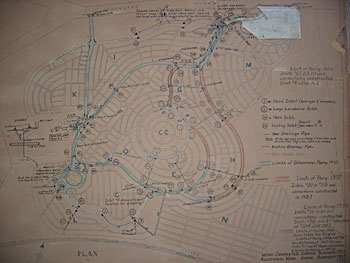Landscape Character and Vegetation
The landscape character of a cemetery includes the natural topography, plantings, lawns, original design intent, and the evolutionary changes that occur within a cemetery. It is essential to identify the character to establish an appropriate and consistent landscape expression for the preservation and interpretation of the cemetery. Landscape features often are a combination of many periods or styles of cemetery design. Cemeteries of the 18th and early 19th century displayed few plantings, while the Rural Cemetery movement of the mid-19th century introduced ornamental plantings, designed landscapes, and varying topography. In the 20th century, there was a return to a more formal landscape, though those changes often reflected different attitudes towards death and the reduction of maintenance budgets and labor forces. Generally, it is accepted that the multiple stages of development are to be preserved and great care and thorough research should be undertaken prior to re-establishing an earlier landscape period or style.
Plantings
Cemetery plantings generally consist of large deciduous shade tress, ornamental shrubs, border shrubs, and ground covers. The first step is to inventory such plantings and simultaneously evaluate which are appropriate to the design and evolution of the cemetery, which require retention and long-term care, and which plantings are invasive and require removal. The next step is to create a long-term maintenance plan for the existing plantings. This should be undertaken with the assistance of a landscape professional and include issues such as inspection, pruning, disease control and fertilization. Finally, if a re-planting campaign is to occur, a specific planting plan should address locations, species, size, maintenance requirements and appropriateness for the cemetery. Native Plants of Pennsylvania are always appropriate (see Landscaping with Native Plants in Pennsylvania).
Extensive new planting plans are best reviewed with a cemetery historian or archaeologist. Plantings should usually be installed by a professional. Ground covers are not necessarily historically appropriate, but they reduce maintenance requirements while others complement the design. Maintain and prune ground covers on a regular basis.
Lawns
The primary ground cover on all sites is normally grass. In older cemeteries it is often in poor condition, with areas of erosion, sloughing, bare spots, weeds, and depressions. Soil stabilization is essential in preserving the character of the cemetery. Erosion and sloughing often lead to the deterioration of marker foundations, pathways and retaining walls, and destructive storm water runoff. The establishment of a dense lawn will help to minimize these side effects. Proper lawn maintenance includes providing good light conditions by reducing heavily shaded area, watering, proper pH levels and fertilization, weed, disease, and pest control, and rolling and aeration. Lawns require mowing on a scheduled basis. Great care in the use of power mowers, weed trimmers, and herbicides must be exercised. Power lawn equipment can scar, chip or break markers, curbing and other features. Weed whips that constantly come in contact with stones can cause long-term damage. Inappropriate herbicides can cause salts to build up in the soil and deteriorate certain stones.
Irrigation and Drainage
Formally designed municipal or rural cemeteries of the 19th and 20th centuries frequently incorporated water systems for irrigation purposes, plus curbing, macadam roadways, and drainage systems. In reviewing the landscape plan of a site, these features should be noted and assessed for their ongoing function. Documented installation plans for water systems, hose bibs, and drainage lines can often be found in cemetery files and assist in locating buried resources for better use or improved maintenance.
 |
| Woodlands Drainage and Irrigation Plan |